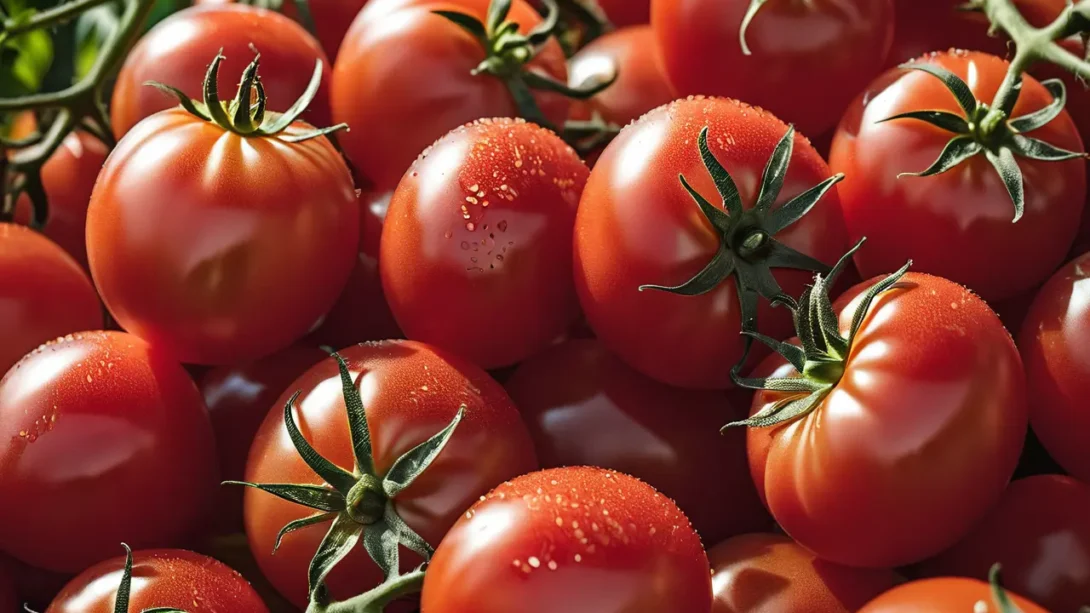Plum tomatoes, with their distinct oblong shape and concentrated flavor, stand out among the myriad varieties of tomatoes cultivated around the globe. Renowned for their thick flesh and fewer seeds, they are particularly favored in the culinary world for making robust sauces and canned tomato products. The popularity of plum tomatoes can be attributed to their versatility in cooking, where they lend themselves well to both fresh and processed dishes, making them a staple in kitchens from Italy to the Americas.
What Are Plum Tomatoes?
Plum tomatoes are a type of tomato recognized for their elongated, plum-like shape, which sets them apart from the rounder varieties commonly found in grocery stores. They typically feature a bright red skin, although there are varieties with yellow or orange hues. What makes plum tomatoes especially prized is their dense, meaty texture with relatively few seeds, and a flavor profile that is both sweet and tangy. This combination of traits makes them exceptionally suitable for cooking down into sauces, as they offer a rich tomato base without the excessive water content found in other varieties.
History and Origin
The journey of plum tomatoes from garden curiosity to kitchen staple is a testament to their adaptability and appeal. Originally cultivated in South America, tomatoes were introduced to Europe and the rest of the world following the Spanish colonization of the Americas. Plum tomatoes, specifically, have roots that trace back to Italy, where they have been grown for generations, particularly in regions like Campania. Here, the volcanic soil provides ideal conditions for cultivating tomatoes with intense flavor profiles, including the celebrated San Marzano plum tomatoes. Over time, the cultivation of plum tomatoes has spread worldwide, with various regions adapting the plant to local climates and culinary preferences.
Culinary Uses
Plum tomatoes are beloved in the culinary world for their robust flavor and versatility. They are the tomatoes of choice for traditional Italian sauces, such as marinara and puttanesca, where their rich taste and thick consistency create the perfect base. Beyond sauces, plum tomatoes are excellent for roasting, canning, and making paste, as their low moisture content allows for concentrated tomato flavor in cooked dishes. When selecting plum tomatoes for cooking, look for firm, brightly colored fruits that are free from blemishes. Preparing them is straightforward: a simple blanching process can remove the skins, and the flesh can be easily diced or crushed for use in recipes.
Varieties of Plum Tomatoes
Plum tomatoes come in several varieties, each with its own unique set of characteristics that cater to different culinary needs and personal tastes. Among the most renowned are the Roma and San Marzano tomatoes. Roma tomatoes are widely available and recognized for their versatility in both fresh and cooked applications, making them a favorite for home gardeners and chefs alike. San Marzano tomatoes, on the other hand, hold a prestigious place in Italian cuisine, particularly valued for their sweet flavor and low acidity, making them the gold standard for traditional Italian tomato sauces and pizzas.
Other notable varieties include the Grape and Cherry plum tomatoes, which are smaller in size but packed with flavor, ideal for salads and snacking. Each variety of plum tomato brings something unique to the table, from the San Marzano‘s rich history and superior sauce quality to the Roma‘s adaptability and all-around culinary utility.
Growing Plum Tomatoes
Growing plum tomatoes can be a rewarding endeavor for both novice and experienced gardeners. These tomatoes thrive in warm, sunny conditions, preferring at least six to eight hours of direct sunlight per day. Well-draining soil enriched with organic matter provides the best foundation for their growth. Starting seeds indoors about six to eight weeks before the last frost date is recommended, with transplantation occurring once the threat of frost has passed and soil temperatures have warmed.
Proper care throughout the growing season is crucial for a bountiful harvest. This includes regular watering, maintaining soil moisture without overwatering, and providing support structures like cages or stakes to support the growing plants. Mulching can help retain soil moisture and control weeds. As the tomatoes grow, it’s important to monitor for pests and diseases, taking action as necessary to protect the crop.
Nutritional Benefits
Plum tomatoes are not only valued for their culinary versatility but also for their nutritional profile. Rich in vitamins C and K, potassium, folate, and antioxidants, they offer several health benefits. The lycopene content in plum tomatoes, a powerful antioxidant, has been linked to reduced risk of heart disease and certain cancers. Compared to other tomato types, plum tomatoes can have a higher concentration of these nutrients due to their denser flesh and lower water content.
Incorporating plum tomatoes into the diet can contribute to heart health, support immune function, and provide essential nutrients for overall well-being. Whether consumed fresh in salads or cooked down into a hearty sauce, plum tomatoes offer a delicious way to enjoy the benefits of a nutrient-rich diet.
Making the Most of Plum Tomatoes in the Kitchen
To fully leverage the culinary potential of plum tomatoes, understanding their best uses is key. For sauces and pastes, plum tomatoes are unparalleled, thanks to their meaty texture and concentrated flavor. They require less cooking time to reduce into a sauce, as their lower water content means there’s less moisture to evaporate. This attribute also makes them ideal for slow-roasted dishes, where their flavors can intensify, adding depth to any recipe. Fresh plum tomatoes can also enhance salads, bruschettas, and sandwiches, offering a firmer, less watery bite than other varieties.
When preparing plum tomatoes, consider peeling and deseeding them for an even smoother texture in sauces and soups. A simple blanch in boiling water followed by a quick cool-down in ice water makes the skin slip off easily. For those looking to preserve the summer’s bounty, plum tomatoes can be canned whole, in sauces, or as pastes, ensuring a supply of rich tomato flavor year-round.
Preserving and Storing Plum Tomatoes
Proper storage is vital to maintain the quality and lifespan of plum tomatoes after harvest. At room temperature, ripe plum tomatoes will last for about a week. To extend their shelf life, consider storing them in the refrigerator, though this may affect their texture and flavor slightly. For long-term preservation, freezing plum tomatoes is an excellent option. They can be frozen whole, sliced, or as a sauce, providing a convenient, flavorful addition to winter meals.
Canning plum tomatoes is another popular method for preservation. Whether packed in water, made into a sauce, or processed as a paste, canned plum tomatoes retain much of their nutritional value and flavor. This method requires some knowledge of safe canning practices to prevent foodborne illnesses, but it rewards with a pantry full of tomatoes ready to be used in any season.
Conclusion
Plum tomatoes occupy a cherished spot in the culinary world, valued for their versatility, rich flavor, and nutritional benefits. From the famed San Marzano to the reliable Roma, each variety brings its own strengths to the table, catering to different tastes and culinary needs. Growing plum tomatoes can be a fruitful endeavor, enriching gardens with vibrant, flavorful fruits that translate into delicious dishes.
In the kitchen, plum tomatoes offer a foundation for countless recipes, from traditional Italian sauces to contemporary culinary creations. Their dense flesh, lower water content, and nutritional profile make them a preferred choice for health-conscious cooks and gourmet chefs alike. By making the most of plum tomatoes, whether fresh, cooked, or preserved, we can enjoy the essence of summer’s bounty throughout the year, celebrating the simple joy and profound flavors these tomatoes bring to our tables.



